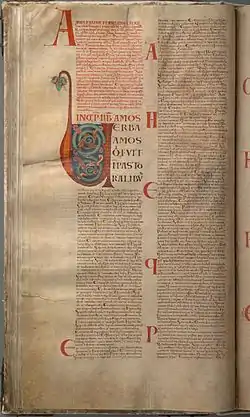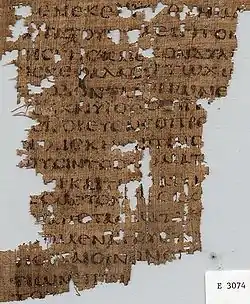Amos 2
Amos 2 is the second chapter of the Book of Amos in the Hebrew Bible or the Old Testament of the Christian Bible.[1][2] This book contains the prophecies attributed to the prophet Amos, especially charges against Moab, Judah, and lastly Israel, the chief subject of Amos' prophecies.[3] It is a part of the Book of the Twelve Minor Prophets.[4][5]
| Amos 2 | |
|---|---|
 | |
| Book | Book of Amos |
| Category | Nevi'im |
| Christian Bible part | Old Testament |
| Order in the Christian part | 30 |
Text
The original text was written in Hebrew language. This chapter is divided into 16 verses.
Textual witnesses
Some early manuscripts containing the text of this chapter in Hebrew are of the Masoretic Text tradition, which includes the Codex Cairensis (895), the Petersburg Codex of the Prophets (916), Aleppo Codex (10th century), Codex Leningradensis (1008).[6]
Fragments containing parts of this chapter were found among the Dead Sea Scrolls including 4Q78 (4QXIIc; 75–50 BCE) with extant verses 11–16;[7][8][9] 4Q82 (4QXIIg; 25 BCE) with extant verses 1, 7–9, 15–16;[7][8][10] and Wadi Murabba'at (MurXII; 75–100 CE) with extant verse 1.[8]
There is also a translation into Koine Greek known as the Septuagint, made in the last few centuries BCE. Extant ancient manuscripts of the Septuagint version include Codex Vaticanus (B; B; 4th century), Codex Alexandrinus (A; A; 5th century), Codex Marchalianus (Q; Q; 6th century)[11][lower-alpha 1] and Papyrus Oxyrhynchus 846 (~550 CE; with extant verses 6–12).[13]
Oracle against Moab (2:1–3)
As Moab is related in some way to the Israel (cf. Genesis 19:30–37), despite the literaty closures, this part with the others seem to form a larger pattern ('sound', verse 2, is qol, cf. 1:2). The crime of Moab probably is more about sacrilege (cf. Jeremiah 8:1–3; cf. 2 Kings 23:16–20), with bones figure mentioned also in 6:9–10; verse 2b echoing 1:14b; and the trumpet reappears in 3:6, in a similar context (cf. Exodus 19:13, 16,19).[14]
Verses 1–3
- 1Thus says the Lord:
- For three transgressions of Moab, and for four,
- I will not turn away its punishment,
- Because he burned the bones of the king of Edom to lime.
- 2But I will send a fire upon Moab,
- And it shall devour the palaces of Kerioth;
- Moab shall die with tumult,
- With shouting and trumpet sound.
- 3And I will cut off the judge from its midst,
- And slay all its princes with him,”
- Says the LORD.[15]
Verse 1 notes
- "He burned the bones of the King of Edom into lime": This profanation of the corpse by the Moab people (cf. 2 Kings 23:16; Jeremiah 8:1, 2) is not mentioned in any historical documents. Some historical commentators, such as Jacobus Tirinus (1580–1636) and Cornelius a Lapide (1567–1637), think that the prophet wants to show that 'the sympathy of God extends beyond the covenant people, and that he punishes wrongs inflicted even on heathen nations'. The event probably happened in relation to the coalition of the king of Edom with Jehoram and Jehoshaphat against Mesha, the King of Moab (2 Kings 3:7, 9), who made inscription on Mesha Stele at Dibon mentioned the war against Edom (unfortunately only some texts remain, as follows: "And Chemosh said to me, Go down, make war against Horonaim [i.e. the men of Edom], and take... Chemosh... in my days. Wherefore I made... year ... and I...") Jerome quotes a Jewish tradition stating that after this war the Moab people dug up and dishonored the bones of king of Edom in revenge for the assistance he had given to the Israelites. Edom was then a vassal of Judah, but regained its independence about ten years later (2 Kings 8:20).[16][3]
Verse 4
- Thus says the Lord:
- "For three transgressions of Judah,
- and for four, I will not revoke the punishment,
- because they have rejected the law of the Lord,
- and have not kept his statutes,
- but their lies have led them astray,
- those after which their fathers walked."[17]
- "For three transgressions of Judah": There is no difference in the treatment of Jews and Gentiles (cf. Romans 2:12. "...as many as have signed in the law, shall be judged by the law", as Jerome notes "those other nations, Damascus and the rest, he upbraids not for having cast away the law of God, and despised His commandments, for they had not the written law, but that of nature only. So then of them he says, that "they corrupted all their compassions" ... but Judah ... had the worship of God and the temple and its rites, and had received the law and commandments ... is rebuked and convicted by the Lord, for that it had "cast aside His law and not kept His commandments;" wherefore it should be punished as it deserved".[18]
Verse 10
- Also I brought you up from the land of Egypt,
- and led you forty years through the wilderness,
- to possess the land of the Amorite.[19]
- and led you forty years through the wilderness,
- "Also I": (literally, "And I") Used by God to remind the people of the good things he did as a motive to obedience (cf. Exodus 20:2; Deuteronomy 5:6; Deuteronomy 6:12).[18]
- "Forty years through the wilderness": During those "forty years" the law was rehearsed and the people were daily supplied with the manna, the water from the rock, as well as the deliverance from the serpents and other dangers, so the journey through the wilderness was not just a punishment but also a blend of kindness (cf. Deuteronomy 1:31; 29:4–5, 32:10,12).[18]
- "The land of the Amorite": refers to the whole land of Canaan as the Amorites were the principal nation of it in the past.[20]
See also
Notes
- The extant Codex Sinaiticus currently does not have the whole Book of Amos.[12]
References
- Collins 2014.
- Hayes 2015.
- Jamieson, Robert; Fausset, Andrew Robert; Brown, David. Jamieson, Fausset, and Brown's Commentary On the Whole Bible, "Amos 2". 1871.
- Metzger, Bruce M., et al. The Oxford Companion to the Bible. New York: Oxford University Press, 1993.
- Keck, Leander E. 1996. The New Interpreter's Bible: Volume: VII. Nashville: Abingdon.
- Würthwein 1995, pp. 35-37.
- Ulrich 2010, p. 604.
- Dead sea scrolls – Amos
- Fitzmyer 2008, p. 38.
- Fitzmyer 2008, p. 39.
- Würthwein 1995, pp. 73-74.
-
 This article incorporates text from a publication now in the public domain: Herbermann, Charles, ed. (1913). "Codex Sinaiticus". Catholic Encyclopedia. New York: Robert Appleton Company.
This article incorporates text from a publication now in the public domain: Herbermann, Charles, ed. (1913). "Codex Sinaiticus". Catholic Encyclopedia. New York: Robert Appleton Company. - John R Abercrombie. 'A History of the Acquisition of Papyri and Related Written Material in the University Museum'. Web publication only, c. 1980.
- Dines 2007, p. 583.
- Amos 2:1–3 NKJV
- Exell, Joseph S.; Spence-Jones, Henry Donald Maurice (Editors). On "Amos 2". In: The Pulpit Commentary. 23 volumes. First publication: 1890. Accessed 24 April 2019.
- Amos 2:4 MEV
- Barnes, Albert. Notes on the Bible - Amos 2. James Murphy (ed). London: Blackie & Son, 1884.
- Amos 2:10 KJV
- Gill, John. Exposition of the Entire Bible. Amos 2. Accessed 24 April 2019.
Sources
- Collins, John J. (2014). Introduction to the Hebrew Scriptures. Fortress Press. ISBN 978-1451469233.CS1 maint: ref=harv (link)
- Dines, Jennifer M. (2007). "29. Amos". In Barton, John; Muddiman, John (eds.). The Oxford Bible Commentary (first (paperback) ed.). Oxford University Press. pp. 581–590. ISBN 978-0199277186. Retrieved February 6, 2019.
- Fitzmyer, Joseph A. (2008). A Guide to the Dead Sea Scrolls and Related Literature. Grand Rapids, MI: William B. Eerdmans Publishing Company. ISBN 978-0802862419.CS1 maint: ref=harv (link)
- Hayes, Christine (2015). Introduction to the Bible. Yale University Press. ISBN 978-0300188271.CS1 maint: ref=harv (link)
- Ulrich, Eugene, ed. (2010). The Biblical Qumran Scrolls: Transcriptions and Textual Variants. Brill.CS1 maint: ref=harv (link)
- Würthwein, Ernst (1995). The Text of the Old Testament. Translated by Rhodes, Erroll F. Grand Rapids, MI: Wm. B. Eerdmans. ISBN 0-8028-0788-7. Retrieved January 26, 2019.

